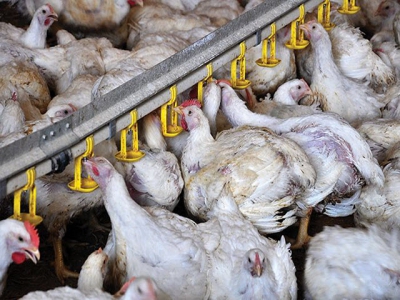Holistic approach to feeding heat-stressed broilers

Water is an excellent medium to administer heat-alleviating compounds. | Orest Lyzhechka, Dreamstime
A quick guide to help adjust feeding programs for broilers to withstand summer heat stress.
Broilers have a short life span, and every day of potential growth lost is a day of potential profit lost. There is nothing like summer heat stress to depress growth potential in all growing animals, and even more so in rapid-growing ones, like broilers. Birds under heat stress simply refuse to eat because the process of eating, digesting and metabolizing feed and nutrients generates heat — and they are obviously trying to reduce their discomfort by avoiding an internal heat source. The following guidelines can be useful in adjusting feeding programs to help broilers suffer less from summer heat stress.
- Adjust feeding management. It might be beneficial to limit access to feeders during times of intense heat, especially when the region is suffering from an unusual heat wave. Perhaps this is not ideal from a growth point of view, but mortality spikes will be avoided — especially among the largest birds. In addition, making sure the water is not exposed to unnecessary sunlight may alleviate some extra discomfort. Providing cool water directly from an underground well can be the ideal solution to ease summer heat stress, but even a simple shade over a water tank can reduce water temperature by a few degrees. Finally, switching from meal to pellets can help increase nutrient ingestion as birds will not fill up so fast as with meal. This is not a real solution, but it might help to increase nutrient uptake during cooler periods when birds start eating again.
- Adjust feed formulations. There are three areas that require attention: energy, protein and fiber. Energy should be slightly increased by adding highly digestible oils or fats replacing starch. Oil generates negligible heat during metabolism. To the same point, protein, the next target in reducing heat generation during metabolism, should be reduced considerably by adding more feed-grade amino acids. Going beyond the traditional 2 to 4 percentage units reduction is possible today as we enjoy new commercial feed-grade amino acids. Finally, fiber nutrition should be re-evaluated during summer. Reducing crude fiber is the regular recommendation, but perhaps we need a different fiber profile so that we keep the beneficial effects without the heat-generating problem. A gut full of fiber promotes bacterial growth and proliferation that generate excessive heat. A gut devoid of fiber might generate less heat, but without antibiotics, pathogenic opportunistic bacteria might cause worse problems.
Although we have several tools to help birds cope with summer heat stress, this does not imply we should use them all at the same time.
- Adjust water supplements. Adding or adjusting certain water supplements might be a good idea during summer. This should be done first, before similar adjustments are attempted in the feed. This is because birds will attempt to drink before they eat, and if we alleviate their stress through water, it might be less expensive to do similar adjustments in feed. Additives such as vitamins (especially vitamin C), organic acids (as we remove fiber from feeds) might require increasing, whereas some medications might need a lower dosage to account for higher water intake.
- Adjust feed additives. In feed, vitamin E is a powerful antioxidant, along with other natural antioxidants. Such can be the case of certain secondary plant compounds found in modern phytogenic products. In general, the more antioxidants we add in the feed and the more diverse their nature, the better as heat stress causes an increased generation of oxidative species. In addition, rethinking the electrolyte balance is a good idea. Additives such as potassium chloride and sodium carbonate are used quite frequently during heat stress. Also, betaine is a potent osmoregulatory (prevents cellular dehydration) but it might be quite expensive at effective doses.
The right approach
Although we have several tools to help birds cope with summer heat stress, this does not imply we should use them all at the same time. Certainly, a combination of different approaches is required, and perhaps recommended, over relying on only one method. The best approach can be different from farm to farm, as not only temperature, but air quality, should be evaluated. A humid environment requires a different approach to a bone-dry climate, whereas a 24-hour constant heat wave necessitates a different management to a cyclical heat-stress condition. Water remains the fastest intervention medium, but it should not preclude the use of the remaining ones.
Nutrition can only alleviate
Having said all this, it is important to realize that any and all nutritional intervention strategies can only alleviate the magnitude of the problem. No matter what we do, heat-stressed broilers will still suffer some degree of growth performance loss. It is only the degree of this loss that we try to manage with these alleviation interventions. Much more can be accomplished by proper placement of buildings according to landscape features, by constructing the proper buildings suitable for each region and equipping them with the necessary air/temperature climate control systems.
Related news
Tools

Phối trộn thức ăn chăn nuôi

Pha dung dịch thủy canh

Định mức cho tôm ăn

Phối trộn phân bón NPK

Xác định tỷ lệ tôm sống

Chuyển đổi đơn vị phân bón

Xác định công suất sục khí

Chuyển đổi đơn vị tôm

Tính diện tích nhà kính

Tính thể tích ao



 Resistant bacteria in intestinal tract linked to antibiotic…
Resistant bacteria in intestinal tract linked to antibiotic…  3 feed tips for managing antibiotic-free animal production
3 feed tips for managing antibiotic-free animal production